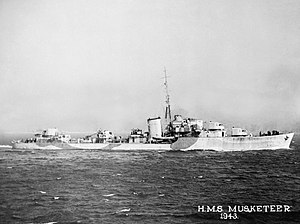
HMAS Nestor (G02) was an N-class destroyer of the Royal Australian Navy (RAN). Built in Scotland, Nestor was commissioned in February 1941; although manned by Australians and commissioned as an Australian warship, she remained the property of the Royal Navy.

HMAS Quadrant (G11/D11/F01), named for the navigational instrument, was a Q-class destroyer operated by the Royal Navy as HMS Quadrant (G67/D17) during World War II, and the Royal Australian Navy (RAN) from 1945 to 1957. The ship was built during the early 1940s as one of the War Emergency Programme destroyers, and entered service in 1942.
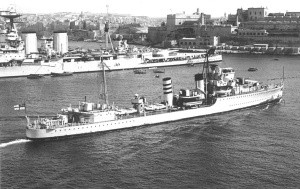
HMS Inglefield was an I-class destroyer leader built for the Royal Navy that served during World War II. She was the navy's last purpose-built flotilla leader. She was named after the 19th century Admiral Sir Edward Augustus Inglefield (1820–1894), and is so far the only warship to carry the name of that seafaring family. In May 1940, her pennant number was changed to I02.

HMAS Norman (G49/D16) was an N-class destroyer operated by the Royal Australian Navy (RAN) during World War II. Entering service in 1941, the ship was on loan from the Royal Navy.

ORP Orkan, formerly HMS Myrmidon, was an M-class destroyer of the Polish Navy during World War II. Orkan is Polish for "hurricane".

HMS Legion was an L-class destroyer of the Royal Navy. She entered service during the Second World War, and had a short but eventful career, serving in Home waters and the Mediterranean. She was sunk in an air attack on Malta in 1942. The ship had been adopted by the British civil community of the Municipal Borough of Cheltenham, Gloucestershire in November 1941.

HMS Punjabi was a Tribal-class destroyer of the Royal Navy that saw service in the Second World War, being sunk in a collision with the battleship King George V. She has been the only ship of the Royal Navy to bear the name "Punjabi" which, in common with the other ships of the Tribal class, was named after various ethnic groups of the world, mainly those of the British Empire.

HMS Matabele was a Tribal-class destroyer of the Royal Navy that saw service in World War II, being sunk by a U-boat on 17 January 1942. She has been the only ship of the Royal Navy to bear the name Matabele, which in common with the other ships of the Tribal class, was named after an ethnic group of the British Empire. In this case, this was the Anglicisation of the Ndebele people of Zimbabwe.

HMS Quail was a Q-class destroyer of the Royal Navy. She served during the Second World War but her career lasted less than a year before she was damaged by a mine and withdrawn from active service.
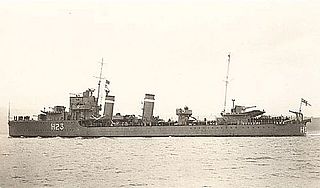
HMS Echo was an E-class destroyer of the British Royal Navy that saw service in the Atlantic, Arctic and Mediterranean theatres during World War II, before being transferred to the Royal Hellenic Navy in 1944, and renamed Navarinon, until scrapped in 1956.

HMS Woolston was a W-class destroyer of the Royal Navy. She served through two world wars, surviving both of them.

HMS Opportune was an O-class destroyer of the Royal Navy. She was ordered from John I. Thornycroft & Company, Woolston on 3 September 1939 for the 1st Emergency Flotilla. She was commissioned on 14 August 1942. She was the second Royal Navy ship borne Opportune.
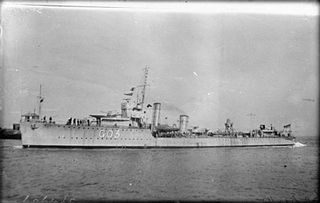
HMS Vortigern was a V-class destroyer of the Royal Navy. She served in both World Wars, and was sunk in 1942.

HMS Mermaid was a Modified Black Swan-class sloop of the Royal Navy. Mermaid saw service as a convoy escort during the Second World War, taking part in the sinking of two German submarines while escorting Arctic convoys to and from the Soviet Union.

HMS Mahratta was an M-class destroyer of the Royal Navy which served during World War II. Begun as Marksman, she was damaged while under construction, and dismantled to be rebuilt on a new slipway. She was launched as Mahratta in 1942, completed in 1943, and quickly pressed into service. After a short but busy career in the North Atlantic and Arctic, largely guarding merchant convoys, she was torpedoed and sunk on 25 February 1944.

HMS Anthony was an A-class destroyer of the Royal Navy. She served in the Second World War.
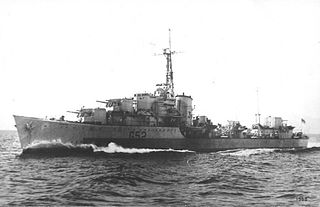
HMS Matchless was an M-class destroyer built during World War II. After the war she was placed in reserve until August 1957 and eventually sold to the Turkish Navy, who renamed her TCG Kılıç Ali Paşa. She was struck from the Turkish Navy list and scrapped in 1971.

The destroyer HNLMS Tjerk Hiddes was a British built, Dutch warship of World War II. She was laid down on 22 May 1940 as a British N-class destroyer and launched on 25 June 1941 as HMS Nonpareil, but on 27 May 1942, she was transferred to the Royal Dutch Navy. The ship was commissioned in 1942 as HNLMS Tjerk Hiddes, named after the 17th century Dutch admiral, Tjerk Hiddes de Vries. Much of her war service was with the Royal Navy and United States Navy in the Indian Ocean and Australia, under the command of W. J. Kruys. Following the war, the destroyer was sold to Indonesia and renamed RI Gadjah Mada. She was scrapped in 1961.

HMS Onslaught was an O-class destroyer of the Royal Navy which entered service in 1941. She was originally to have been named Pathfinder, but this was changed during construction. She was adopted by the Isle of Wight as part of the Warship Week campaign in 1942. After the Second World War she was sold to Pakistan and scrapped in 1977.

HMS Obedient was an O-class destroyer of the Royal Navy. She was built by William Denny and Brothers of Dumbarton, between 1940 and 1942. During Warship Week in 1942 she was adopted by the civil community of Lymington, United Kingdom. She was scrapped in 1962.
